Abstract
1. Longitudinal muscle strips from the rat gastric fundus were subjected to in vitro electrical field stimulation (EFS) under non-adrenergic non-cholinergic (NANC) conditions to study the release of peptide histidine isoleucine-like immunoreactivity (PHI-LI) and the correlation between PHI-LI release and NANC relaxation. 2. Different radioimmunoassay (RIA) systems employing C-terminal- and N-terminal-specific anti-PHI sera were used to determine the relative contributions of PHI and its C-terminally extended forms, peptide histidine glycine (PHI-Gly) and peptide histidine valine [PHV(1-42)], to the PHI-LI released by the rat gastric fundus. 3. In the presence of atropine (1 microM) and guanethidine (5 microM), EFS (120 mA, 1 ms, 0.25-32.0 Hz, trains of 2 min) induced frequency-dependent relaxations of 5-hydroxytryptamine (3 microM) pre-contracted strips. 4. EFS at frequencies of 8-32 Hz evoked significant increases in PHI-LI outflow. The increases in PHI-LI outflow evoked by 16-Hz EFS were abolished by tetrodotoxin (3 microM) and by a calcium-free medium, indicating an active release process from intramural nerves. 5. The EFS-induced release of PHI-LI measured with the N-terminal-specific antiserum was significantly greater than that detected with the C-terminal-specific antisera. 6. Sephadex G-25 gel permeation chromatographic analysis was performed on the PHI-LI release in response to 32-Hz EFS. A C-terminal-specific antiserum revealed one peak co-eluting with the rat PHI standard. When PHI-LI was measured with the N-terminal-specific antiserum, two peaks were found that co-eluted with the rat PHV(1-42) and rat PHI-Gly/PHI standards, respectively.(ABSTRACT TRUNCATED AT 250 WORDS)
Full text
PDF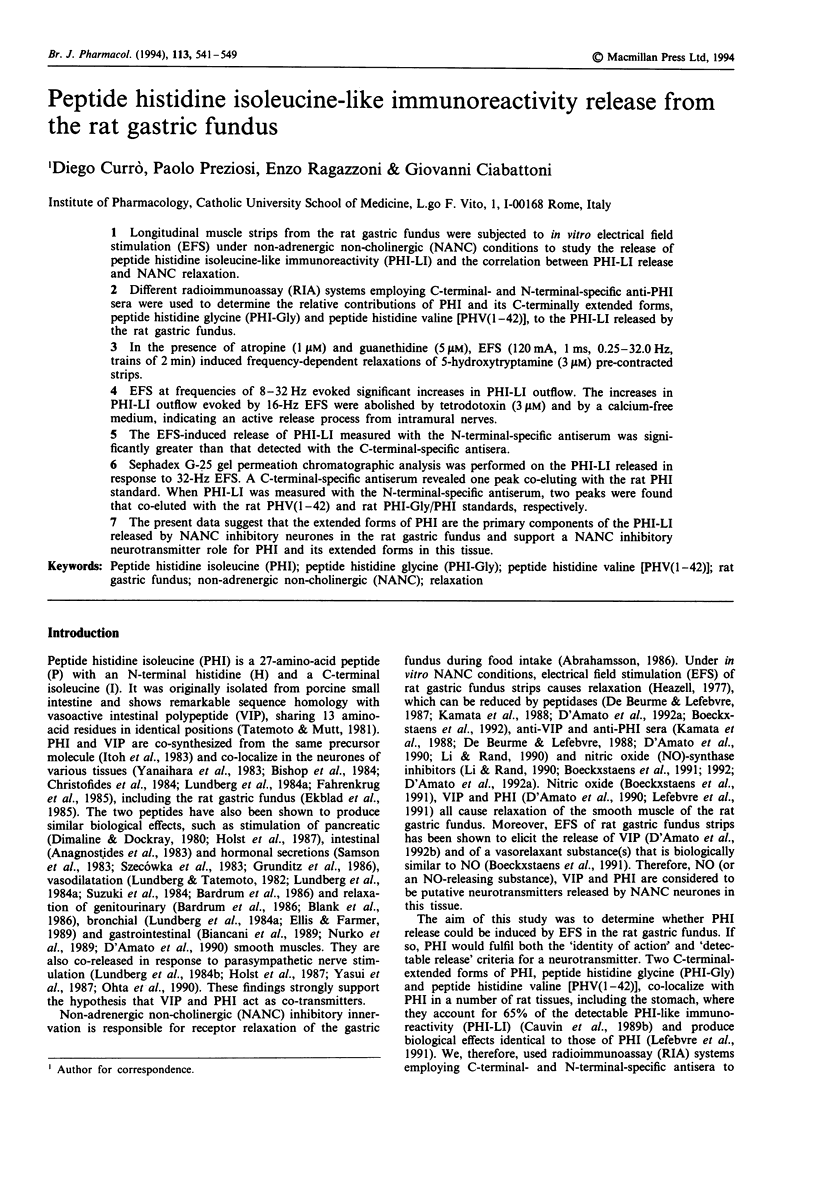
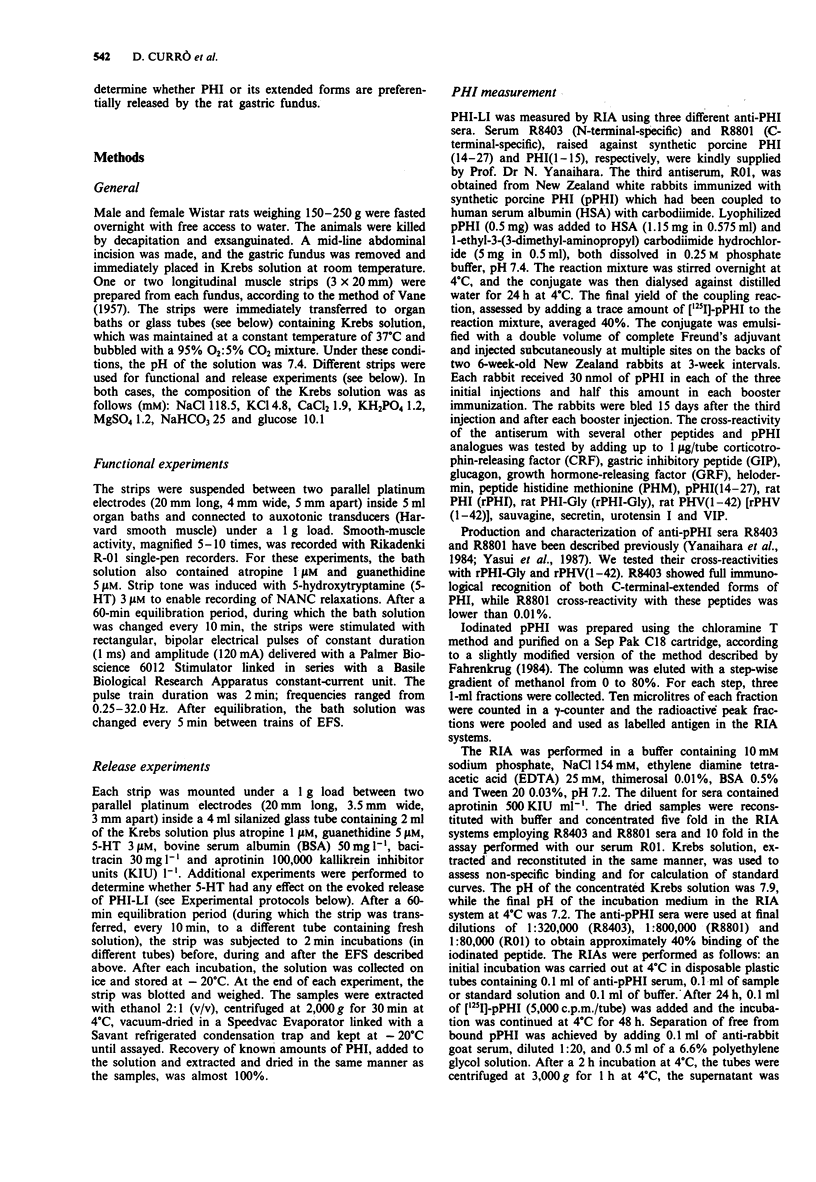
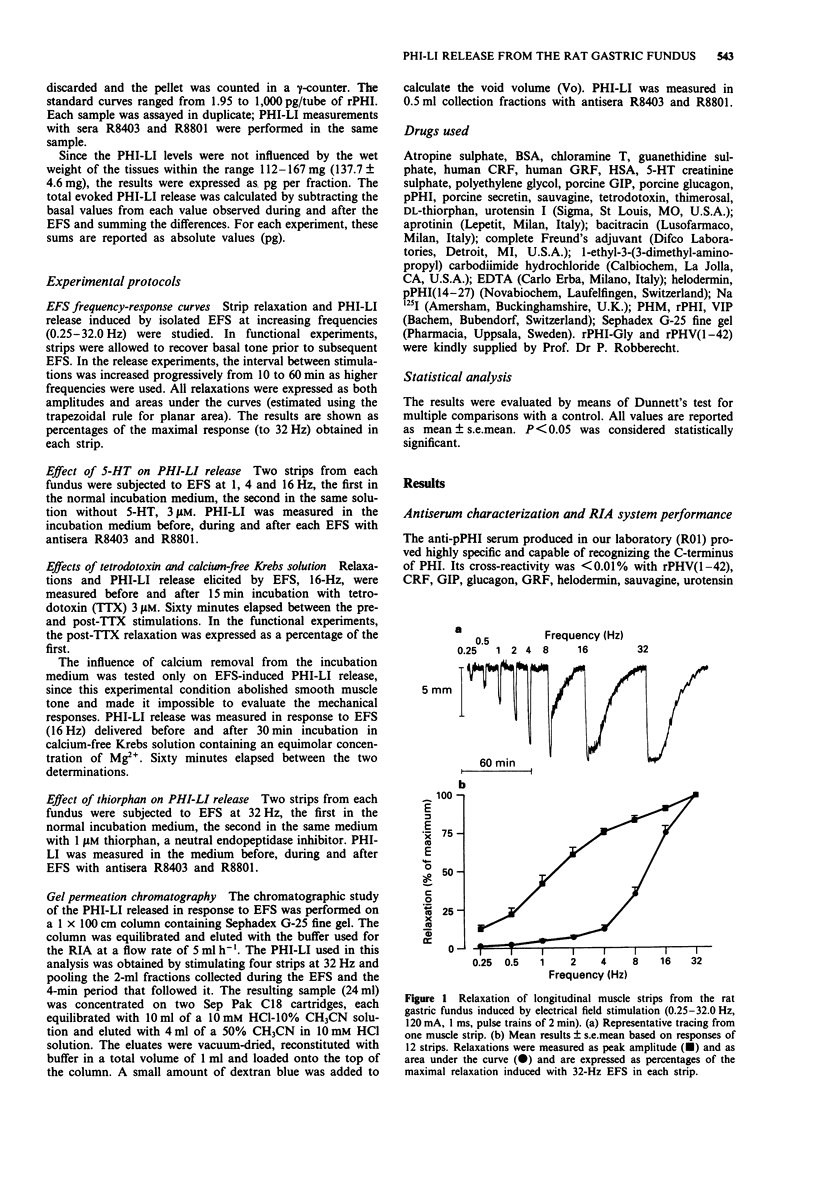
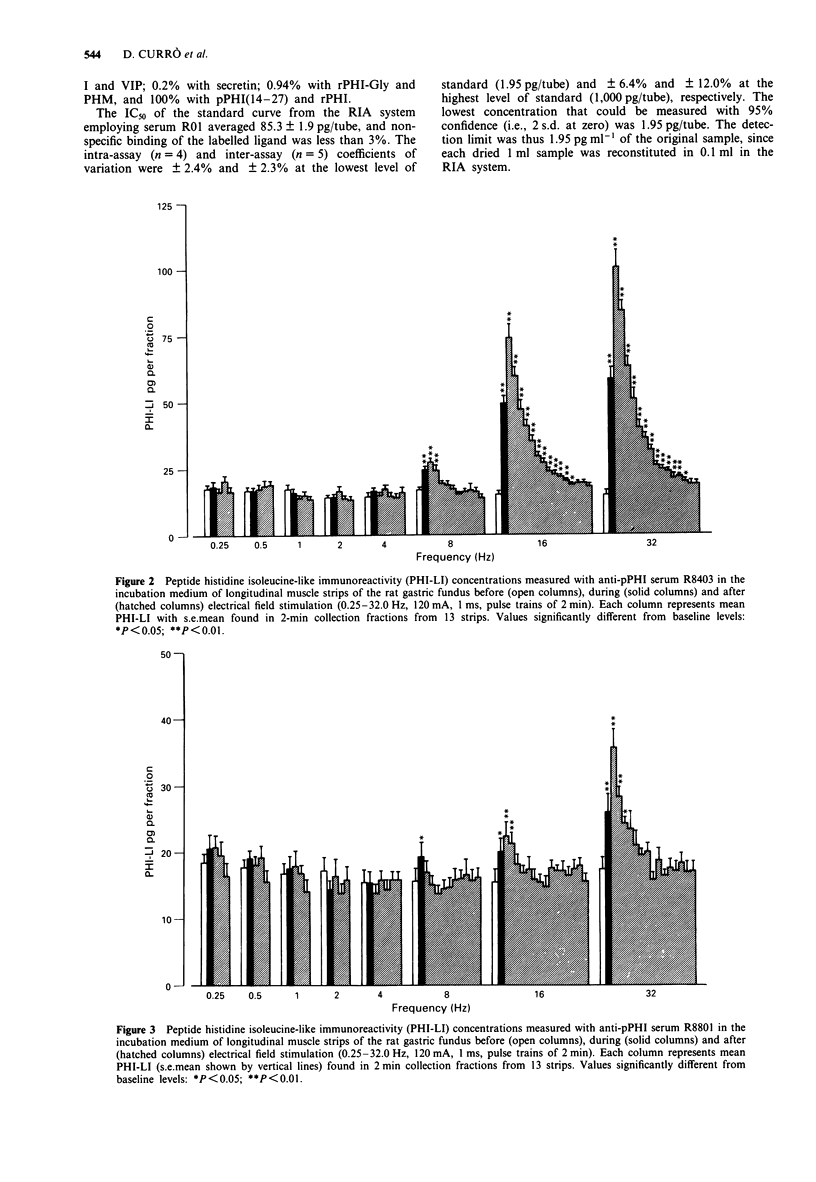
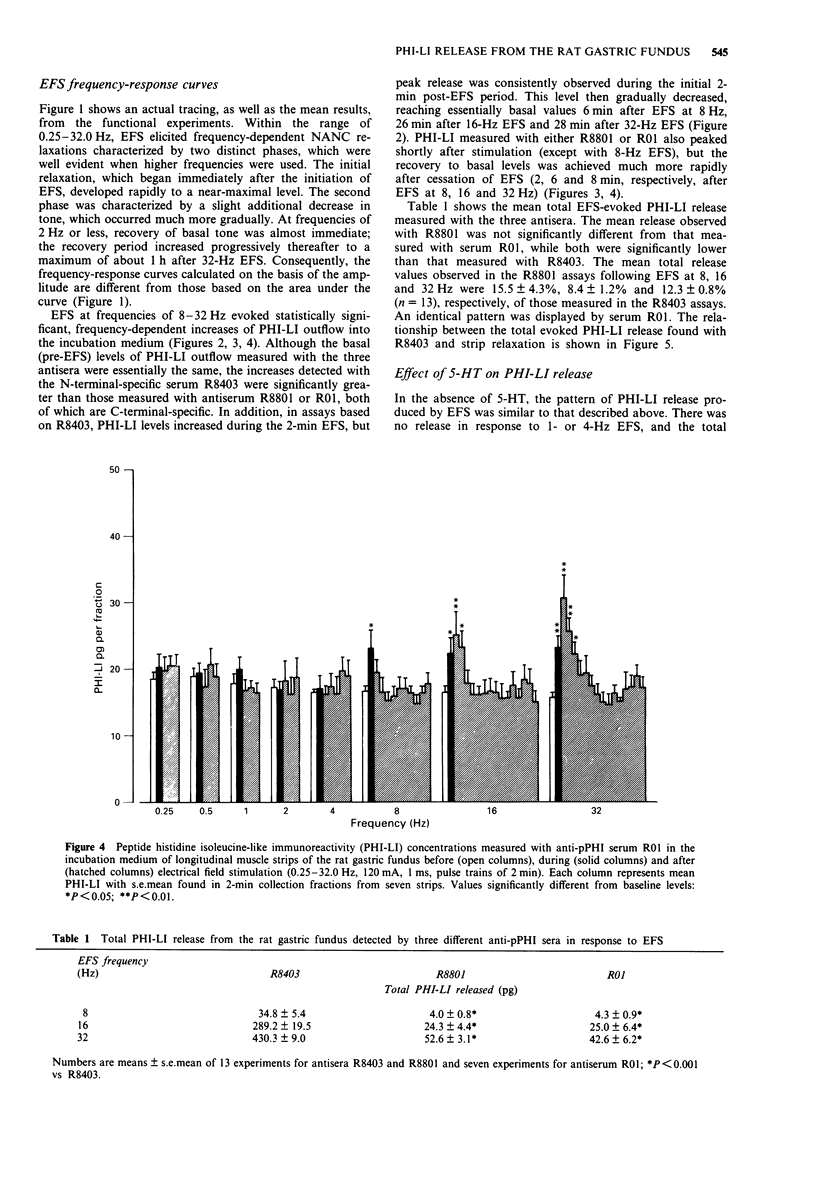
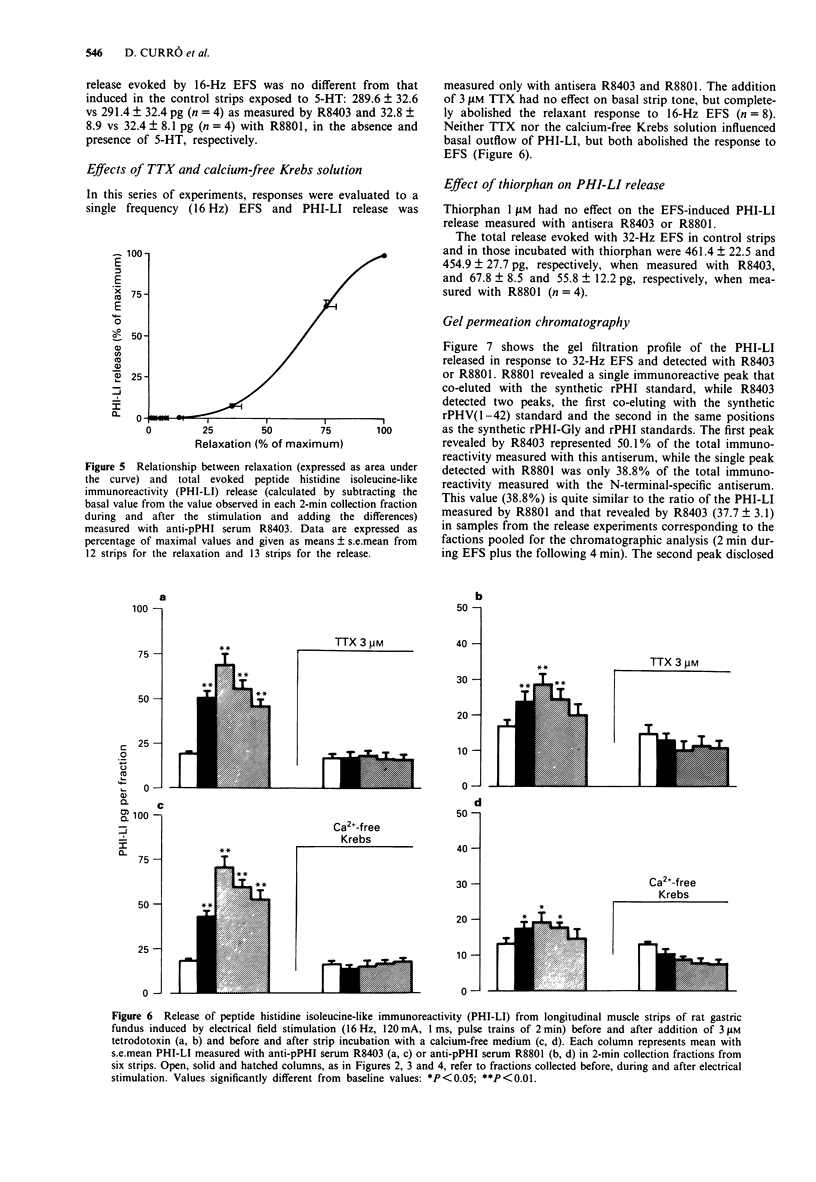
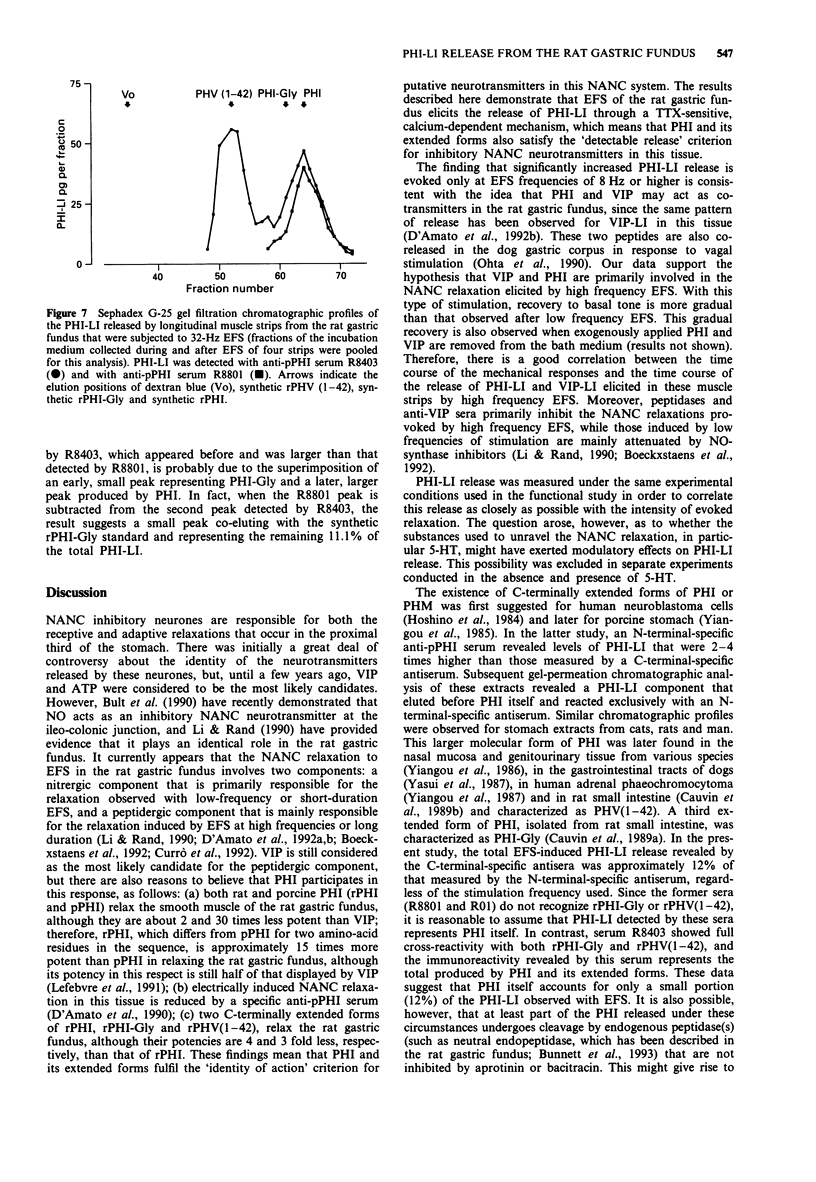
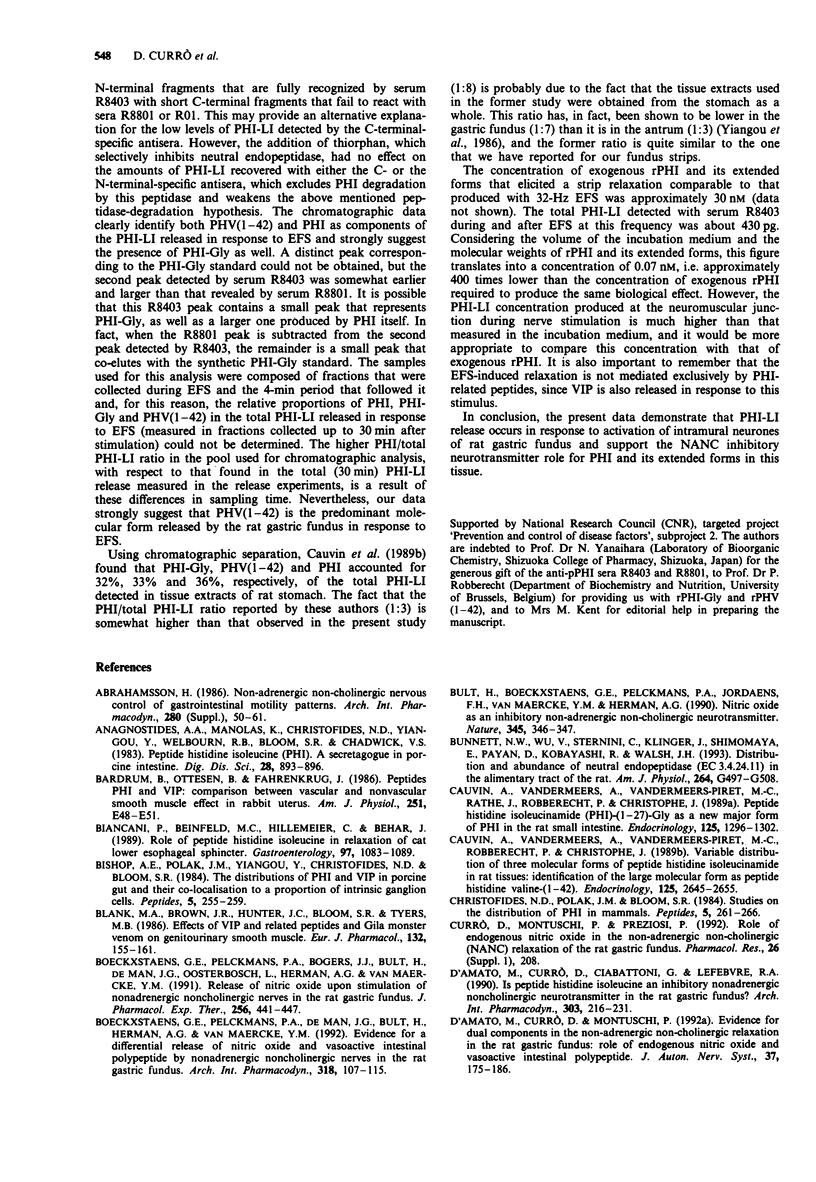
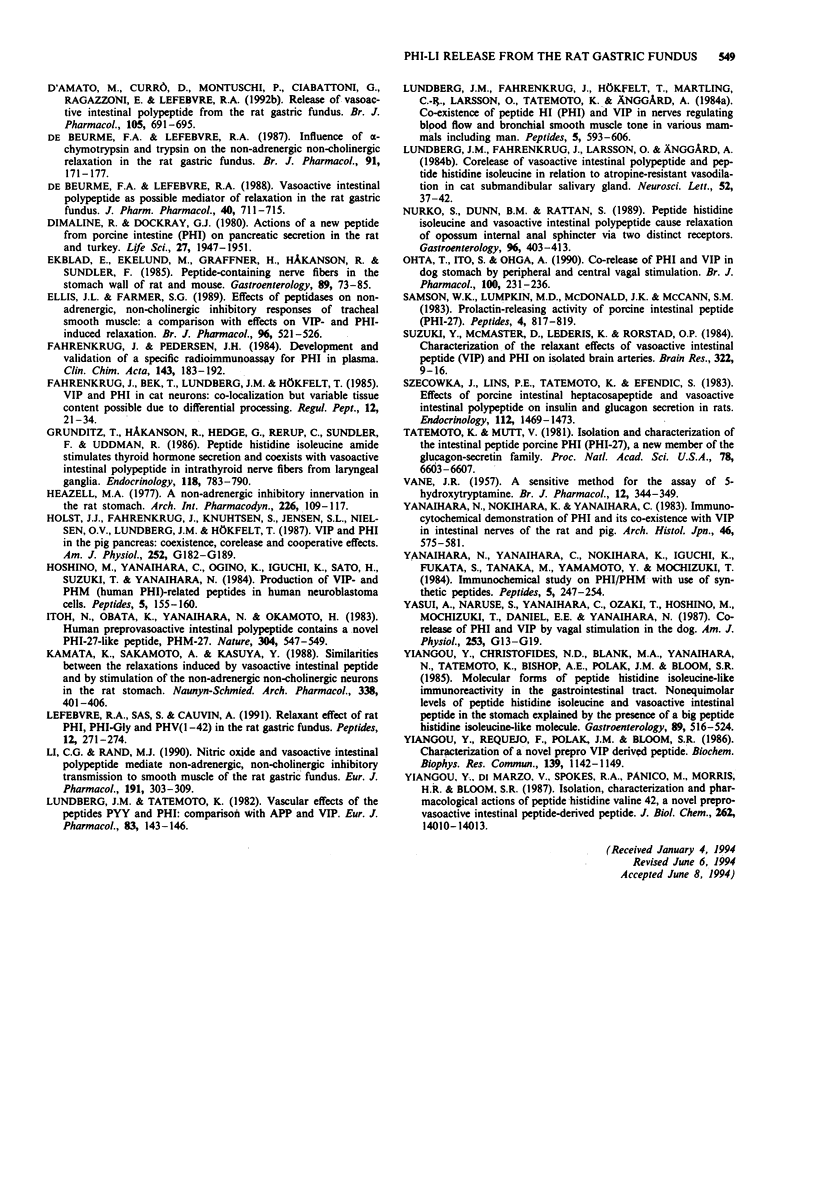
Selected References
These references are in PubMed. This may not be the complete list of references from this article.
- Abrahamsson H. Non-adrenergic non-cholinergic nervous control of gastrointestinal motility patterns. Arch Int Pharmacodyn Ther. 1986 Apr;280(2 Suppl):50–61. [PubMed] [Google Scholar]
- Anagnostides A. A., Manolas K., Christofides N. D., Yiangou Y., Welbourn R. B., Bloom S. R., Chadwick V. S. Peptide histidine isoleucine (PHI). A secretagogue in porcine intestine. Dig Dis Sci. 1983 Oct;28(10):893–896. doi: 10.1007/BF01317039. [DOI] [PubMed] [Google Scholar]
- Bardrum B., Ottesen B., Fahrenkrug J. Peptides PHI and VIP: comparison between vascular and nonvascular smooth muscle effect in rabbit uterus. Am J Physiol. 1986 Jul;251(1 Pt 1):E48–E51. doi: 10.1152/ajpendo.1986.251.1.E48. [DOI] [PubMed] [Google Scholar]
- Biancani P., Beinfeld M. C., Hillemeier C., Behar J. Role of peptide histidine isoleucine in relaxation of cat lower esophageal sphincter. Gastroenterology. 1989 Nov;97(5):1083–1089. doi: 10.1016/0016-5085(89)91675-2. [DOI] [PubMed] [Google Scholar]
- Bishop A. E., Polak J. M., Yiangou Y., Christofides N. D., Bloom S. R. The distributions of PHI and VIP in porcine gut and their co-localisation to a proportion of intrinsic ganglion cells. Peptides. 1984 Mar-Apr;5(2):255–259. doi: 10.1016/0196-9781(84)90215-8. [DOI] [PubMed] [Google Scholar]
- Blank M. A., Brown J. R., Hunter J. C., Bloom S. R., Tyers M. B. Effects of VIP and related peptides and Gila monster venom on genitourinary smooth muscle. Eur J Pharmacol. 1986 Dec 16;132(2-3):155–161. doi: 10.1016/0014-2999(86)90600-x. [DOI] [PubMed] [Google Scholar]
- Boeckxstaens G. E., Pelckmans P. A., Bogers J. J., Bult H., De Man J. G., Oosterbosch L., Herman A. G., Van Maercke Y. M. Release of nitric oxide upon stimulation of nonadrenergic noncholinergic nerves in the rat gastric fundus. J Pharmacol Exp Ther. 1991 Feb;256(2):441–447. [PubMed] [Google Scholar]
- Boeckxstaens G. E., Pelckmans P. A., De Man J. G., Bult H., Herman A. G., Van Maercke Y. M. Evidence for a differential release of nitric oxide and vasoactive intestinal polypeptide by nonadrenergic noncholinergic nerves in the rat gastric fundus. Arch Int Pharmacodyn Ther. 1992 Jul-Aug;318:107–115. [PubMed] [Google Scholar]
- Bult H., Boeckxstaens G. E., Pelckmans P. A., Jordaens F. H., Van Maercke Y. M., Herman A. G. Nitric oxide as an inhibitory non-adrenergic non-cholinergic neurotransmitter. Nature. 1990 May 24;345(6273):346–347. doi: 10.1038/345346a0. [DOI] [PubMed] [Google Scholar]
- Bunnett N. W., Wu V., Sternini C., Klinger J., Shimomaya E., Payan D., Kobayashi R., Walsh J. H. Distribution and abundance of neutral endopeptidase (EC 3.4.24.11) in the alimentary tract of the rat. Am J Physiol. 1993 Mar;264(3 Pt 1):G497–G508. doi: 10.1152/ajpgi.1993.264.3.G497. [DOI] [PubMed] [Google Scholar]
- Cauvin A., Vandermeers A., Vandermeers-Piret M. C., Rathe J., Robberecht P., Christophe J. Peptide histidine isoleucinamide (PHI)-(1-27)-Gly as a new major form of PHI in the rat small intestine. Endocrinology. 1989 Sep;125(3):1296–1302. doi: 10.1210/endo-125-3-1296. [DOI] [PubMed] [Google Scholar]
- Cauvin A., Vandermeers A., Vandermeers-Piret M. C., Robberecht P., Christophe J. Variable distribution of three molecular forms of peptide histidine isoleucinamide in rat tissues: identification of the large molecular form as peptide histidine valine-(1-42). Endocrinology. 1989 Nov;125(5):2645–2655. doi: 10.1210/endo-125-5-2645. [DOI] [PubMed] [Google Scholar]
- Christofides N. D., Polak J. M., Bloom S. R. Studies on the distribution of PHI in mammals. Peptides. 1984 Mar-Apr;5(2):261–266. doi: 10.1016/0196-9781(84)90216-x. [DOI] [PubMed] [Google Scholar]
- D'Amato M., Currò D., Ciabattoni G., Lefebvre R. A. Is peptide histidine isoleucine an inhibitory nonadrenergic noncholinergic neurotransmitter in the rat gastric fundus? Arch Int Pharmacodyn Ther. 1990 Jan-Feb;303:216–231. [PubMed] [Google Scholar]
- D'Amato M., Currò D., Montuschi P., Ciabattoni G., Ragazzoni E., Lefebvre R. A. Release of vasoactive intestinal polypeptide from the rat gastric fundus. Br J Pharmacol. 1992 Mar;105(3):691–695. doi: 10.1111/j.1476-5381.1992.tb09040.x. [DOI] [PMC free article] [PubMed] [Google Scholar]
- D'Amato M., Currò D., Montuschi P. Evidence for dual components in the non-adrenergic non-cholinergic relaxation in the rat gastric fundus: role of endogenous nitric oxide and vasoactive intestinal polypeptide. J Auton Nerv Syst. 1992 Mar;37(3):175–186. doi: 10.1016/0165-1838(92)90039-j. [DOI] [PubMed] [Google Scholar]
- De Beurme F. A., Lefebvre R. A. Influence of alpha-chymotrypsin and trypsin on the non-adrenergic non-cholinergic relaxation in the rat gastric fundus. Br J Pharmacol. 1987 May;91(1):171–177. doi: 10.1111/j.1476-5381.1987.tb08996.x. [DOI] [PMC free article] [PubMed] [Google Scholar]
- Dimaline R., Dockray G. J. Actions of a new peptide from porcine intestine (PHI) on pancreatic secretion in the rat and turkey. Life Sci. 1980 Nov 24;27(21):1947–1951. doi: 10.1016/0024-3205(80)90413-0. [DOI] [PubMed] [Google Scholar]
- Ekblad E., Ekelund M., Graffner H., Håkanson R., Sundler F. Peptide-containing nerve fibers in the stomach wall of rat and mouse. Gastroenterology. 1985 Jul;89(1):73–85. doi: 10.1016/0016-5085(85)90747-4. [DOI] [PubMed] [Google Scholar]
- Ellis J. L., Farmer S. G. Effects of peptidases on non-adrenergic, non-cholinergic inhibitory responses of tracheal smooth muscle: a comparison with effects on VIP- and PHI-induced relaxation. Br J Pharmacol. 1989 Mar;96(3):521–526. doi: 10.1111/j.1476-5381.1989.tb11848.x. [DOI] [PMC free article] [PubMed] [Google Scholar]
- Fahrenkrug J., Bek T., Lundberg J. M., Hökfelt T. VIP and PHI in cat neurons: co-localization but variable tissue content possible due to differential processing. Regul Pept. 1985 Sep;12(1):21–34. doi: 10.1016/0167-0115(85)90183-1. [DOI] [PubMed] [Google Scholar]
- Fahrenkrug J., Pedersen J. H. Development and validation of a specific radioimmunoassay for PHI in plasma. Clin Chim Acta. 1984 Nov 30;143(3):183–192. doi: 10.1016/0009-8981(84)90068-8. [DOI] [PubMed] [Google Scholar]
- Grunditz T., Håkanson R., Hedge G., Rerup C., Sundler F., Uddman R. Peptide histidine isoleucine amide stimulates thyroid hormone secretion and coexists with vasoactive intestinal polypeptide in intrathyroid nerve fibers from laryngeal ganglia. Endocrinology. 1986 Feb;118(2):783–790. doi: 10.1210/endo-118-2-783. [DOI] [PubMed] [Google Scholar]
- Heazell M. A. A non-adrenergic inhibitory innervation in the rat stomach. Arch Int Pharmacodyn Ther. 1977 Mar;226(1):109–117. [PubMed] [Google Scholar]
- Holst J. J., Fahrenkrug J., Knuhtsen S., Jensen S. L., Nielsen O. V., Lundberg J. M., Hökfelt T. VIP and PHI in the pig pancreas: coexistence, corelease, and cooperative effects. Am J Physiol. 1987 Feb;252(2 Pt 1):G182–G189. doi: 10.1152/ajpgi.1987.252.2.G182. [DOI] [PubMed] [Google Scholar]
- Hoshino M., Yanaihara C., Ogino K., Iguchi K., Sato H., Suzuki T., Yanaihara N. Production of VIP- and PHM (human PHI)-related peptides in human neuroblastoma cells. Peptides. 1984 Mar-Apr;5(2):155–160. doi: 10.1016/0196-9781(84)90199-2. [DOI] [PubMed] [Google Scholar]
- Itoh N., Obata K., Yanaihara N., Okamoto H. Human preprovasoactive intestinal polypeptide contains a novel PHI-27-like peptide, PHM-27. Nature. 1983 Aug 11;304(5926):547–549. doi: 10.1038/304547a0. [DOI] [PubMed] [Google Scholar]
- Kamata K., Sakamoto A., Kasuya Y. Similarities between the relaxations induced by vasoactive intestinal peptide and by stimulation of the non-adrenergic non-cholinergic neurons in the rat stomach. Naunyn Schmiedebergs Arch Pharmacol. 1988 Oct;338(4):401–406. doi: 10.1007/BF00172117. [DOI] [PubMed] [Google Scholar]
- Lefebvre R. A., Sas S., Cauvin A. Relaxant effect of rat PHI, PHI-Gly and PHV(1-42) in the rat gastric fundus. Peptides. 1991 Mar-Apr;12(2):271–274. doi: 10.1016/0196-9781(91)90010-m. [DOI] [PubMed] [Google Scholar]
- Li C. G., Rand M. J. Nitric oxide and vasoactive intestinal polypeptide mediate non-adrenergic, non-cholinergic inhibitory transmission to smooth muscle of the rat gastric fundus. Eur J Pharmacol. 1990 Dec 4;191(3):303–309. doi: 10.1016/0014-2999(90)94162-q. [DOI] [PubMed] [Google Scholar]
- Lundberg J. M., Fahrenkrug J., Hökfelt T., Martling C. R., Larsson O., Tatemoto K., Anggård A. Co-existence of peptide HI (PHI) and VIP in nerves regulating blood flow and bronchial smooth muscle tone in various mammals including man. Peptides. 1984 May-Jun;5(3):593–606. doi: 10.1016/0196-9781(84)90090-1. [DOI] [PubMed] [Google Scholar]
- Lundberg J. M., Fahrenkrug J., Larsson O., Anggård A. Corelease of vasoactive intestinal polypeptide and peptide histidine isoleucine in relation to atropine-resistant vasodilation in cat submandibular salivary gland. Neurosci Lett. 1984 Nov 23;52(1-2):37–42. doi: 10.1016/0304-3940(84)90347-1. [DOI] [PubMed] [Google Scholar]
- Lundberg J. M., Tatemoto K. Vascular effects of the peptides PYY and PHI: comparison with APP and VIP. Eur J Pharmacol. 1982 Sep 10;83(1-2):143–146. doi: 10.1016/0014-2999(82)90300-4. [DOI] [PubMed] [Google Scholar]
- Nurko S., Dunn B. M., Rattan S. Peptide histidine isoleucine and vasoactive intestinal polypeptide cause relaxation of opossum internal anal sphincter via two distinct receptors. Gastroenterology. 1989 Feb;96(2 Pt 1):403–413. doi: 10.1016/0016-5085(89)91564-3. [DOI] [PubMed] [Google Scholar]
- Ohta T., Ito S., Ohga A. Co-release of PHI and VIP in dog stomach by peripheral and central vagal stimulation. Br J Pharmacol. 1990 Jun;100(2):231–236. doi: 10.1111/j.1476-5381.1990.tb15787.x. [DOI] [PMC free article] [PubMed] [Google Scholar]
- Samson W. K., Lumpkin M. D., McDonald J. K., McCann S. M. Prolactin-releasing activity of porcine intestinal peptide (PHI-27). Peptides. 1983 Nov-Dec;4(6):817–819. doi: 10.1016/0196-9781(83)90073-6. [DOI] [PubMed] [Google Scholar]
- Suzuki Y., McMaster D., Lederis K., Rorstad O. P. Characterization of the relaxant effects of vasoactive intestinal peptide (VIP) and PHI on isolated brain arteries. Brain Res. 1984 Nov 19;322(1):9–16. doi: 10.1016/0006-8993(84)91175-2. [DOI] [PubMed] [Google Scholar]
- Szecówka J., Lins P. E., Tatemoto K., Efendić S. Effects of porcine intestinal heptacosapeptide and vasoactive intestinal polypeptide on insulin and glucagon secretion in rats. Endocrinology. 1983 Apr;112(4):1469–1473. doi: 10.1210/endo-112-4-1469. [DOI] [PubMed] [Google Scholar]
- Tatemoto K., Mutt V. Isolation and characterization of the intestinal peptide porcine PHI (PHI-27), a new member of the glucagon--secretin family. Proc Natl Acad Sci U S A. 1981 Nov;78(11):6603–6607. doi: 10.1073/pnas.78.11.6603. [DOI] [PMC free article] [PubMed] [Google Scholar]
- VANE J. R. A sensitive method for the assay of 5-hydroxytryptamine. Br J Pharmacol Chemother. 1957 Sep;12(3):344–349. doi: 10.1111/j.1476-5381.1957.tb00146.x. [DOI] [PMC free article] [PubMed] [Google Scholar]
- Yanaihara N., Nokihara K., Yanaihara C., Iwanaga T., Fujita T. Immunocytochemical demonstration of PHI and its co-existence with VIP in intestinal nerves of the rat and pig. Arch Histol Jpn. 1983 Sep;46(4):575–581. doi: 10.1679/aohc.46.575. [DOI] [PubMed] [Google Scholar]
- Yanaihara N., Yanaihara C., Nokihara K., Iguchi K., Fukata S., Tanaka M., Yamamoto Y., Mochizuki T. Immunochemical study on PHI/PHM with use of synthetic peptides. Peptides. 1984 Mar-Apr;5(2):247–254. doi: 10.1016/0196-9781(84)90214-6. [DOI] [PubMed] [Google Scholar]
- Yasui A., Naruse S., Yanaihara C., Ozaki T., Hoshino M., Mochizuki T., Daniel E. E., Yanaihara N. Corelease of PHI and VIP by vagal stimulation in the dog. Am J Physiol. 1987 Jul;253(1 Pt 1):G13–G19. doi: 10.1152/ajpgi.1987.253.1.G13. [DOI] [PubMed] [Google Scholar]
- Yiangou Y., Christofides N. D., Blank M. A., Yanaihara N., Tatemoto K., Bishop A. E., Polak J. M., Bloom S. R. Molecular forms of peptide histidine isoleucine-like immunoreactivity in the gastrointestinal tract. Nonequimolar levels of peptide histidine isoleucine and vasoactive intestinal peptide in the stomach explained by the presence of a big peptide histidine isoleucine-like molecule. Gastroenterology. 1985 Sep;89(3):516–524. doi: 10.1016/0016-5085(85)90445-7. [DOI] [PubMed] [Google Scholar]
- Yiangou Y., Di Marzo V., Spokes R. A., Panico M., Morris H. R., Bloom S. R. Isolation, characterization, and pharmacological actions of peptide histidine valine 42, a novel prepro-vasoactive intestinal peptide-derived peptide. J Biol Chem. 1987 Oct 15;262(29):14010–14013. [PubMed] [Google Scholar]
- Yiangou Y., Requejo F., Polak J. M., Bloom S. R. Characterization of a novel prepro VIP derived peptide. Biochem Biophys Res Commun. 1986 Sep 30;139(3):1142–1149. doi: 10.1016/s0006-291x(86)80296-0. [DOI] [PubMed] [Google Scholar]


